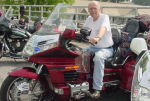 |
 |
 |
|
The Art of the Motorcycle - A Review Back in 1998, there was an exhibition at the Guggenheim Museum in New York called The Art of the Motorcycle. I thought about going but never did. I heard that more people attended that exhibition than any other show they had ever held at the Guggenheim. The show was heavily discussed among the motorcycling community in the greater New York area. Well, I knew that they had issued a book about the show but it was expensive so I didn't buy it. Later as I started writing more about motorcycles, I saw the need to learn about the bikes that shaped the history of motorcycles and so I finally bought it for my library. I was pleasantly surprised. I now see well kept versions of this book going for thousands of dollars on the open market. I spent the better part of a day going through the book. It's a big one and heavy. It has over 400 pages of pictures, essays, and descriptions of the 100 or so motorcycles that were on display in 1998. I'll be making this book available in my Motorcycles Bookstore. What I want to do in the remainder of this article is give you a flavor for the types of bikes in the book. I can't go into much detail. I do want to see if I can't convince you that you need to have this book. I picked a random selection of 10 bikes that interested me. These are not the ten best or anything like that. You'd probably pick a different 10. 1894 Hildebrand & Wolfmuller: This German bike was the first referred to as a Motorrad, the German word for motorcycle. It had a 1489cc engine that was the largest made for the next 90 years. It failed in 1897 when the company finally realized that the selling price was less than what it cost to make it. 1901 Indian Single: The first Indian was made in Springfield, Mass. USA by the Hendee Manufacturing Company. In 1923, as a result of a company reorganization, the company name was changed to The Indian Motocycle Company. They purposely left off the "r" to avoid copyright and patent problems. 1922 Megola Sport: This German bike had five cylinders in a star formation in the center of the front wheel. This unusual bike is featured on the front cover of the book. 1923 BMW R32: This was the original flat-twin engine with shaft drive that put BMW into the motorcycle business with a design that has continued to the end of the 20th Century. 1940 Crocker: This was called the Duesenberg of Motorcycles. It had a 45 degree V-twin that was the forerunner of the post war custom. The president of the company offered full purchase price back to anyone who was beaten on the road by a stock Indian or Harley-Davidson. 1940 Indian Sport Scout "Bob-Job": Southern California returning soldiers bought used motorcycles, not cars. They then shortened or bobbed the rear fenders and removed the front fenders completely. They were used for speed on the dry lakes. Riders bump-started them holding on to a handle on the back of the rear seat. This style then evolved into the Chopper which has chopped off fenders and trim. By then, the handle on the back of the seat had turned into the sissy bar found on choppers. 1948 Indian Chief: This bike debuted in 1922 and was the main competition to the Harley-Davidson V-twin heavyweight. It was discontinued in 1953 when the company went out of business. 1957 Harley-Davidson Sportster XL: This was the first Harley-Davidson engine to be named the "Shovelhead." It also had the name of the bike cast into the gear-case cover, last done by H-D for the Silent Grey Fellow. 1963 Honda C100 Super Cub: This bike was also called the 50 Super Cub. It established Honda's reputation in the USA. It used plastic parts for the first time to reduce weight and cost. A total of 26 million have been made since then. 1970 Honda CB750 Four: This bike used a transverse-mounted, overhead camshaft, in-line 750 four. It remains the most popular design in use today. It had electric start, hydraulic disc brakes, and sold for a modest $1500. It made motorcycling what it is today. You may remember the Poll held on this Web site to determine the most influential motorcycle built in the last 100 years. Visitors to the Motorcycles site picked the CB750 as their number one choice. Each of these bikes contributed to the evolution of motorcycling. You'll have to read the complete book to find out all the details. That will keep you enjoyably entertained for many evenings.

|
|||||
© 2013 Walter F. Kern. All rights reserved.
|





